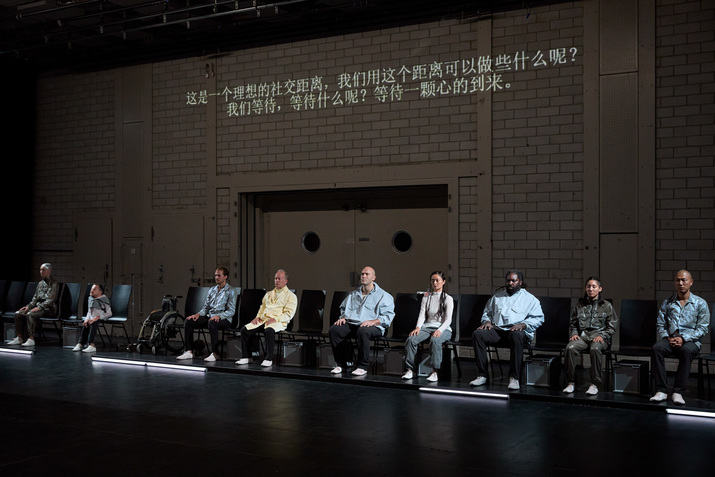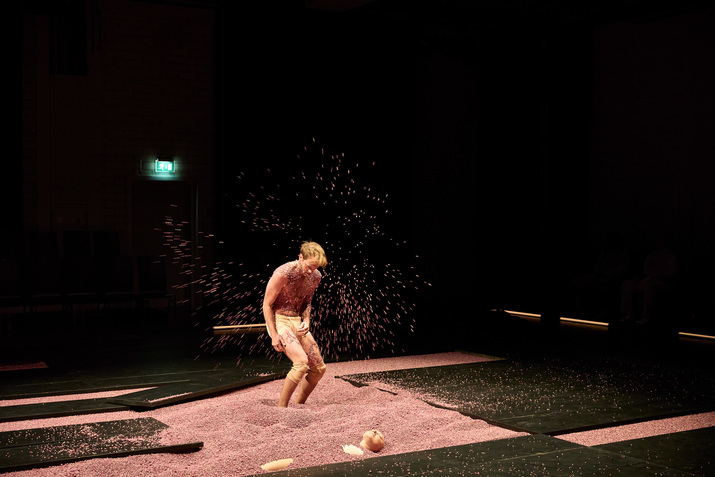-
From Current Issue
-
- Editor’s Letter Fire in the Heart
- Reviews I Gusti Ayu Kadek Murniasih
- Reviews 11th Seoul Mediacity Biennale: “One Escape at a Time”
- Dispatch Networked China
- One on One Monira Al Qadiri on Yukio Mishima
- Essays The rise of independent art spaces in pandemic-era Shanghai
- Features Tuan Andrew Nguyen
- Table of Contents
- Web Exclusives
- Archive
- Subscribe

R
E
V N
E
X
T
Photo documentation of PAPER TIGER THEATER’s Heart Chamber Fragments, 2021, stage performance: two hours, at Munich Kammerspiele, 2021. All images courtesy the artist and Munich Kammerspiele.
Unlike contemporary Chinese artists such as Ai Weiwei and Yue Minjun or writers like Mo Yan and Yan Lianke, Chinese theater directors and their collectives rarely achieve widespread name recognition. While images and texts travel well enough, multi-hour performances require a certain physical architecture and funding ecosystem in order to be staged across the world, which makes the ongoing residency of Beijing’s Paper Tiger Theater Studio in Berlin both a rare treat and a performance-art event in its own right.
Under the guidance of its founding director Tian Gebing, and in collaboration with a German ensemble, the collective recently premiered their latest theater piece, Heart Chamber Fragments (2021), at the Munich Kammerspiele. The culmination of four years of research and the second work of a trilogy loosely based on texts by Franz Kafka, the performance (in German and Chinese) draws upon Jean-Luc Nancy’s essay “The Intruder,” Kafka’s unfinished short story “The Burrow,” and Tao Yuanming’s Utopian fable “The Peach Blossom Spring” to create a dense patchwork of allusions to the fragility and resilience of the human body (and its soulful organ in particular) amid external threats. That the performance has been staged during a pandemic only added to its contemporaneity.
As the performance opens, Swiss actor Stefan Merki informs the audience of the imminent arrival of a heart before launching into a clinical discourse about heart transplants, while the nine-person ensemble sits motionless behind him. What follows is a video of an actual cardiologist discussing the differences between the human and pig heart. Eventually emerging from these long shadows cast by medical science, the dancers discard their surgical scrubs and soon coalesce into a ritualistic simulacrum of a sacrificial offering, which culminates when two of them, Spaniard Manel Salas Palau and German Erwin Aljukić, engage in a rhythmic performance, their synchronous movements eventually disintegrating into chaos. Fragility and strength, synchronicity and rejection, beauty and violence—the kinetic push-pull gestures here embody the tensions in Nancy’s relationship with his own transplanted heart, which he described in his essay as “becoming a stranger to me, intruding through its defection—almost through rejection, if not dejection.”
Such afferent performative sequences reach their zenith in a scene involving dancer Cindy Ng and her erratically violent but beautiful changes in rhythm, speed, and direction as she stalks and clings to fellow performer Martin Weigel. At one point, Ng tries to burrow under Weigel’s shirt, but is driven back, only to repeat the attack again with the same result. Ng appears caught in a labyrinth of her own making, at once a refuge as well as a self-made dead end from which there is no apparent exit. Tian hints at the self-aggrandizing neuroticism that plagues the master builder in Kafka’s story and that propels the hyper-rationalized, single-minded pursuit that ensnares the character. At the conclusion of Heart Chamber Fragments, the performance space’s floor ruptures and the performers are slowly swallowed by gravity’s downward force, with one walking voluntarily into the abyss. Has she discovered her utopia or been buried by her delusions?
The challenge in writing about Tian’s multimedia, deconstructed, and processional aesthetic approach reflects some of the challenges of postdramatic theater, which, as scholar Hans-Thies Lehmann defined it, is “when the progression of a story with its internal logic no longer forms the centre, when composition is no longer experienced as an organizing quality but as an artificially imposed ‘manufacture.’” In the hands of an accomplished director and theater collective—and Tian and his ensemble are at the forefront of contemporary experimental theater—the effect for audiences can be as exhilaratingly hypnotic as it is disorienting.
With the focus no longer primarily on the text itself, visual dramaturgy demands that we dwell in the images of the performance. Science, technology, and medicine pervade the visual language of Heart Chamber Fragments, but it is also a language of sounds, movements, shapes, lighting, props, and film. By inviting us to explore individual meanings within this polyphony of visual and aural experiences, Paper Tiger continues to merge theater and the visual arts in an attempt to expand the very language of contemporary theater itself.
Paper Tiger Theater Studio’s “Heart Chamber Fragments” was at the Munich Kammerspiele from October 7 to November 10, 2021.
To read more of ArtAsiaPacific’s articles, visit our Digital Library.













